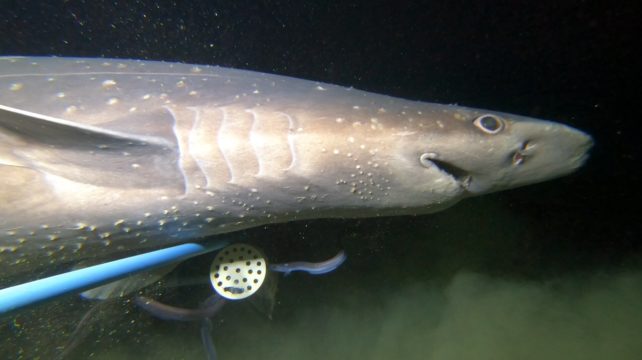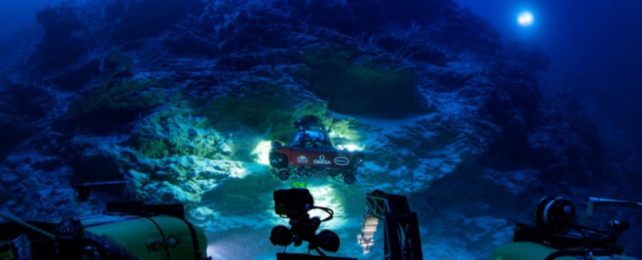A team of 'aquanauts' has discovered the Maldives is an oasis for deep ocean life in a large watery desert.
A recent submarine mission around a deepwater seamount in the archipelago has revealed a new kind of thriving ecosystem, which researchers say has never been described before.
They're calling it 'The Trapping Zone': a 500-meter-deep (1,640 ft) world where large fish congregate to feast on microscopic nekton.
Micronekton are similar to zooplankton, although slightly larger, between 2 and 20 centimeters (up to 7 inches) in size (krill are among the smaller ones).
These tiny organisms actively swim between the surface of the ocean and waters a kilometer deep, creating a vertical wave of migration each day and night as larger fish follow them to feed.
The Nekton Maldives Mission is the first study to systematically map the deep waters of the Maldives, a chain of 26 coral atolls southwest of Sri Lanka and India.
The mission is a venture between a non-profit research institute of the same name, the Government of the Maldives, and researchers at the University of Oxford.
Already, the international team has stumbled on a new ecosystem surrounding the 'Satho Rahaa' deep-sea mountain, based on the movement of micronekton.
As the Sun rises each day, these tiny organisms begin to swim downwards from the surface. Near the sunken seamount, however, submerged volcanic ridges and fossilized carbonate reefs formed 60 million years ago stop micronekton from diving deeper than around 500 meters.
Trapped by the topography, the animals become 'sitting ducks' for larger predators, such as schools of tuna, hungry sharks, and other deepwater fish like spiky oreos, alfonsinos, and dog fish, which reside in the zone.
In a glass bubble submarine, known as the Omega Seamaster II, aquanauts on the mission watched as a teeming ecosystem of predators and prey battled it out in the deep.
Not only did the team count great numbers of fish, they also saw great diversity. Their submarine turned its light on tiger sharks, gill sharks, gulper sharks, scalloped hammerhead sharks, silky sharks, sand tiger sharks, and even bramble sharks, which are relatively rare.
"Why is this occurring? Is this something that's specific at 500 meters, does this life go even deeper, what is this transition, what is there, and why?" wonders marine scientist Lucy Woodall from the University of Oxford.
"This will enable us to understand the deep ocean in much better terms."

If such an ecosystem exists in the Maldives, it's likely to be found on other oceanic islands with similar underwater structures.
Perhaps seamounts and submerged volcanoes are hotspots for deep-sea life because of the way they ensnare micronekton.
The back-and-forth vertical movement of fish through the water column each day is, by some estimates, the largest mass migration on the planet.
Zooplankton and micronekton seem to be the leaders of the pack. Yet despite the fact that micronekton make up a huge portion of the biomass in pelagic environments, our understanding of their migratory behavior pales in comparison to zooplankton.
By actively swimming up and down the water column, micronekton are weaving an overlooked food web for ocean ecosystems all around the world. By some estimates, all the micronekton in the world weigh over 10 billion metric tons, 45 times heavier than all of us humans.
Most of what we know of these creatures, however, dates back to the 1960s and 1970s. Only recently have they started to receive more attention from scientists.
Micronekton can easily slip through fishing nets, and as a result, they are not commercially hunted. That said, many species that are important to the fishing industry, like tuna, closely depend on micronekton.

The trapping zone recently found in the Maldives could allow scientists to get to know these overlooked organisms in a whole new way, possibly allowing for better ocean conservation practices.
"This has all the hallmarks of a distinct new ecosystem," says marine biologist Alex Rogers from the University of Oxford.
"The Trapping Zone is creating an oasis of life in the Maldives and it is highly likely to exist in other oceanic islands and also on the slopes of continents."
Unfortunately, recent climate reports suggest that some micronekton in some parts of the world, like krill in Antarctica, are not coping well with the crisis of global warming.
If they disappear, other fish, mammals, and birds are likely to follow.
You can read more about the Nekton Maldives Mission here.
